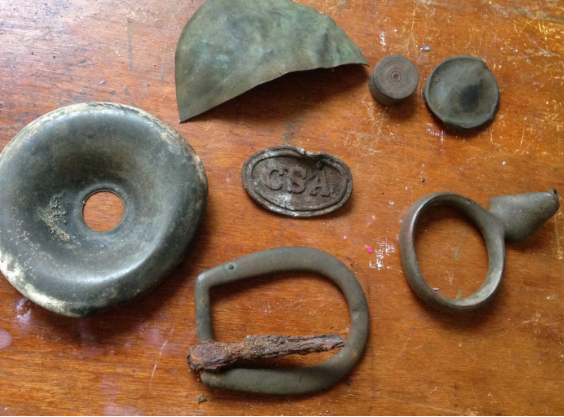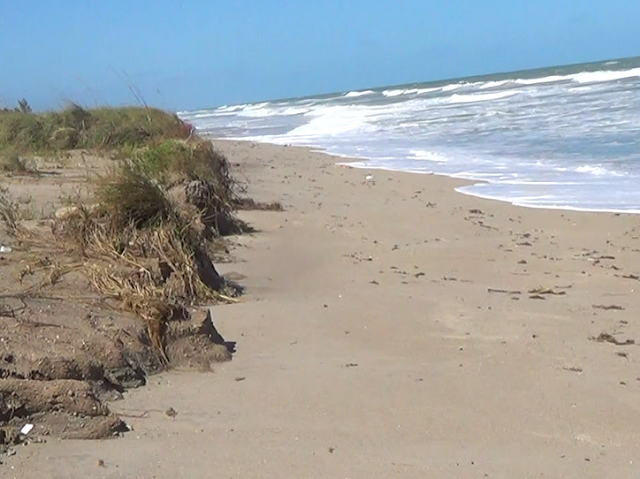Written by the TreasureGuide for the exclusive use of treasurebeachesreport.blogspot.com.
 |
| Find Photo By Dan B. |
Notice the small CSA plate in the middle. That could get a person excited.
As I often say, the find is sometimes only the beginning of the hunt. That is especially true if you are a relic hunter. After the find comes the research to find out as much as you can about the item.
Dan did his research.
 |
| Pictures of CSA Cap Gun Set. |
Good research Dan!
---
I started to talk about strategies the other day. It can be a complex and lengthy subject. One of the first things is to define your goals. The goals of a modern jewelry hunter will usually be economic. They want to find the most valuable finds that they can.
Non-detectorists usually assume that treasure hunters are driven by economics. They assume that they are in it for the money, and they often ask, "What is the most valuable thing you ever found." That can be a difficult question for many detectorists to answer because they are interested in things other than the economic value of their finds. Some want to find old things or unusual things or things that tell a story. They might not ever want to sell anything. That is not why they hunt.
One of the most important things in developing an effective strategy is to know exactly what you want to accomplish. Why are you detecting and what do you want to find? Sometimes people detect just for the fun of it or the exercise.
I mentioned a few days ago about when I was digging tons of clad coins. If I was trying to maximize the economic value of my finds, I might not be interested in digging tons of clad. It would hardly pay off economically. There are other reasons to dig clad though. One is to gather information. You can gather information about what went on at the location, how long things been accumulating there, how old are the items that are being uncovered, and where the items are coming from - for example if they washing out of the dunes or being washed up onto the beach out of the water.
You can tell a lot from the distribution of coins. If you are finding a disproportionate number of nickles for example, maybe someone usually detects that area discriminating out targets in the nickle/aluminum range.
Zinc pennies will often be near the outside borders of a coin line or coin hole while quarters will be nearer the center and also closer to gold rings. If you are detecting a lot of pennies, that is just a bit off of detecting a lot of aluminum. In either case, you might want to move towards the heavier items.
Another reason to dig clad is to uncover things that might be associated with the coins or masked by the coins. Pennies and other things can mask better targets. I often find that after clearing away a coin hole, I am then able to find targets in the area that I did not notice before when all of the coins were in the way. After clearing away the loud targets, listen for the more subtle signals.
Be clear about your preferences. Be clear about how you value things. That will help you be more strategic in your detecting.
I'll continue with this topic in the future.
---
A bronze buckle and a cylindrical metal bead found in Alaska are the first hard evidence of trade between Asia and the indigenous peoples of the North American Arctic, centuries before contact with Europeans, archaeologists say.
An analysis of the artifacts has shown that they were smelted in East Asia out of lead, copper, and tin, before finding their way to an indigenous village some 700 years ago...
http://westerndigs.org/asian-metal-found-in-alaska-reveals-trade-centuries-before-european-contact/
---
For more than a decade, evidence has been piling up that humans colonized the Americas thousands of years before the Clovis people. The Clovis, who are the early ancestors of today's Native Americans, left abundant evidence of their lives behind in the form of tools and graves. But the mysterious pre-Clovis humans, who likely arrived 17,000 to 15,000 years ago, have left only a few dozen sources of evidence for their existence across the Americas, mostly at campsites where they processed animals during hunting trips. Now a fresh examination of one such campsite, a 14,000-year-old hunter's rest stop outside the city of Tres Arroyos in Argentina, has given us a new understanding of how the pre-Clovis people might have lived.
http://arstechnica.com/science/2016/09/14000-year-old-campsite-in-argentina-adds-to-an-archaeological-mystery/
---
The surf has decreased down to around four feet or less and will remain about that for the rest of the week. I'm not anticipating any improvement in detecting conditions until possibly around a week from now.
Happy Halloween,
TreasureGuide@comcast.net









































